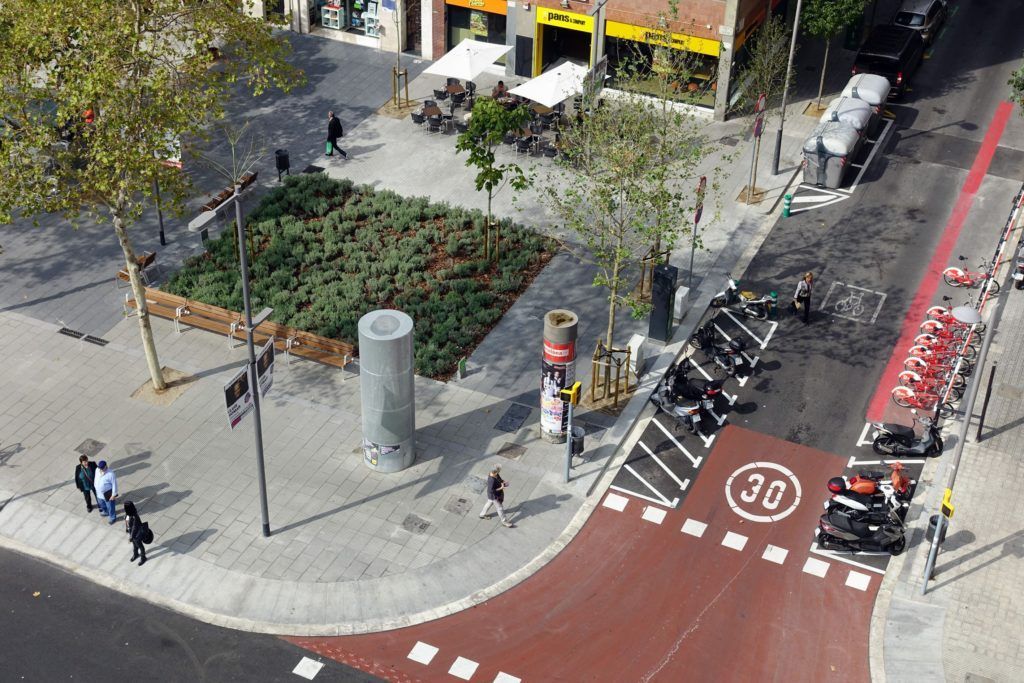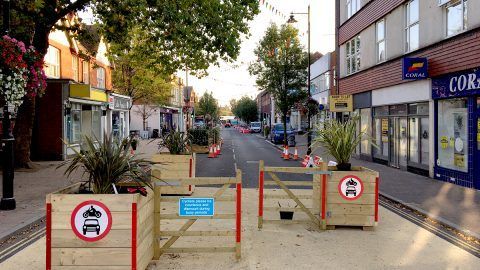
Traffic calming consists of physical design and other measures put in place on existing roads to reduce vehicle speeds and volumes to improve safety for pedestrians and cyclists, as well as reduce noise, pollution and generally improve the environment. The most common forms of extensive traffic calming are
Speed Control Measures and
Volume Control Measures.
Low Speed Zones (LSZ) restrict speeds to 30 kph (20 mph) or 20 kph (12 mph) for school zones or shared spaces.
Low Traffic Neighbourhoods (LTNs) have been introduced in the UK as a type of LSZ to reduce through traffic in residential areas.
Traffic Calming improvement measures comprise the following topics:
n
Low Speed Zones (LSZs)
Low Speed Zones (LSZs) are designed to reduce motor vehicle speeds to improve safety within sensitive areas such as school zones, residential neighborhoods or central business districts. Traffic-calming (and Tactical Urbanism) measures ensure that motor vehicles respect the target speed within the LSZ which is usually 30 kph (20 mph). This is usually reduced to 10 to 20 kph around schools, hospitals, places of worship, locations with high percentages of children, older people, or people with disabilities or shared spaces. Lane widths in LSZs with target speeds of 30 km/h should be 2.5 to 2.7 metres (and no wider than 3 metres) to ensure self-enforcement of the target speed.
Developing LSZs involves packaging traffic calming measures for transitions, gateways, streets, and intersections.
- Transitions and gateways provide visual and physical cues to motorists before they enter the LSZ lower speed environment.
- On Slow Streets (also known as Complete Streets) roadways should be narrowed, vehicles should be limited to local access and encouraged to drive slowly to make the street safer for other users (Barcelona has recently made all single lane streets 30 kph).
- Intersections should be provided with min-roundabouts with clear pedestrian crossings and refuge islands.
n
Low Traffic Neighbourhoods (LTNs)
Low Traffic Neighbourhoods (LTNs) have been introduced in the UK as a type of LSZ to reduce through traffic in residential areas through traffic calming by stopping cars, vans and other vehicles from using quiet roads as shortcuts. They have been introduced to improve the quality of life for local residents and making it easier for them to choose walking or cycling for local journeys. LTNs can be implemented through the use of barriers such as bollards, boom barriers and planters, automatic number-plate recognition cameras and road signs, which can allow residential motor access while prohibiting passing motor traffic. Implementation is progressive and starts with consultation with local residents, followed by pilot experimental schemes using temporary wooden planters which narrow the street in certain locations, and prevent through-traffic. The final stage involves installing permanent features such as additional crossing points, continuous footways, dropped kerbs and other accessibility infrastructure, pedestrian and cycling infrastructure, trees and planting, speed limits, etc. There is evidence to show that LTNs lead to a decrease in car use, increase in walking and cycling and a decrease in noise, pollution, street crime, violent crime and sexual assaults.
n
Speed Control Measures
Speed control measures are designed to slow traffic by changing the vertical or horizontal alignment or narrowing the roadway. Speed control measures comprise:
Narrowing Roadways (Slow Streets)
Narrowing Roadways is a fundamental measure to lower speed by reducing lane widths, widening footpaths and pavements, by using kerb extensions (also called "bulbouts") at pedestrian crossings, by installing chokers (to narrow the roadway to a single lane at selected points) and by establishing pedestrian refuges or small islands in the middle of the roadway. Lane narrowing remove excess width from existing traffic lanes without changing the number of lanes. Lane removals, also known as "road diets," reassign underused traffic lanes to other functions.
Speed Humps
Speed Humps are placed across a road to slow traffic and are often installed in a series of several humps to prevent cars from speeding before and after the hump. They have a traverse distance of about 3.7 to 4.3 m and span the width of the road. The height ranges from 76 to 102 mm. The traverse distance and height of each hump determines the speed at which traffic will travel over the devices (typically they limit vehicle speeds to about 24–32 km/h).
Speed Cushions
Speed Cushions are two or more raised areas placed laterally across a roadway. Their height and length are comparable to the dimensions of a Speed Hump. The primary difference is that a speed cushion has gaps between the raised areas to enable cyclists and large vehicles (such as buses and emergency vehicles) to pass without slowing down while reducing car speeds.
Speed Tables
Speed Tables have a flat top, typically 6–9 m long (generally long enough for the entire wheelbase of a passenger car to rest on top) and rise to meet the grade of the sidewalk, providing safe and comfortable crossings for walkers and wheelchairs. When they are combined with pedestrian crossings they are called raised crossings. Speed reductions resulting from 7-metre speed tables are 32–48 kilometres per hour and they are effective in maintaining speed limits rather than slowing cars more significantly.
Rumble Strips
Rumble Strips produce vibrations and audible rumbling above a given target speed. They provide visual and aural cues to alert drivers to areas that require special care (shopping centers, schools, entrances to residential neighborhoods). Materials such as granite and concrete are roughened by being broken into raised lines or patterns, and placed in strips across roadways, usually in a series. Drivers can lessen the vibration and the abrasive sound they create by slowing down.
Raised Intersections
Raised Intersections create a safe, slow-speed crossing and public space at minor intersections. Similar to speed tables, they reinforce slow speeds and encourage motorists to yield to pedestrians at the crosswalk. Raised Intersections are the same height as the sidewalk to ensure that drivers traverse the crossing slowly and provide safe and comfortable crossings for walkers and wheelchairs. For visually impared pedestrians it is advisable to provide detectable warning strips to delineate the edge between the sidewalk and the roadway.
Chicanes and Lane Shifts
Chicanes and Lane Shifts form an S-shaped path of travel which lowers vehicle speeds. Chicanes work best on low volume roadways with lower speed limits, making them ideal for residential neighbourhoods. Kerb and sidewalk extensions, parking spots, or planter boxes can be used to create chicanes, providing both neighborhood functionality and safety.
Mini Roundabouts
Mini roundabouts (traffic circles in the USA) reduce speeds, organize traffic and remind drivers that they must proceed carefully. They are round islands designed to fit within the travel lanes of an existing intersection and they are usually installed at 3 or 4-armed junctions (but not at junctions with five or more arms). The central island should be between 1 and 4 metres in diameter and can be a painted area or a low dome (no more than 125mm high), or both, designed to be fully traversable by emergency vehicles. Special attention should be given to providing safe navigation for cyclists, especially where bike lanes are present on junction arms.
n
Volume Control Measures
Volume-control measures discourage through traffic while maintaining local access by restricting vehicle access and reducing speeds. A clear signage strategy should be provided to ensure drivers do not circulate around trying to find a through route. Traffic flow studies and temporary closures can be used to check the effect that such closures will have.
Volume control measures include full street closures, half closures, diagonal diverters, median barriers, and forced-turn islands. They comprise landscaped islands, decorative walls, steel posts, bollards or planters, or any other means that leave an opening narrower than an automobile. They should be designed to maintain emergency vehicle access.
The most effective volume control measures are "diagonal dividers". These are physical barriers placed diagonally across a four-legged intersection to block through movement. These types of street closures are most appropriate for neighborhood areas with grid network streets where through traffic is a significant problem. These measures have been used extensively in Europe and the USA as well as in the Superblock programme in Barcelona and the Kiezblock programme in Berlin.
















